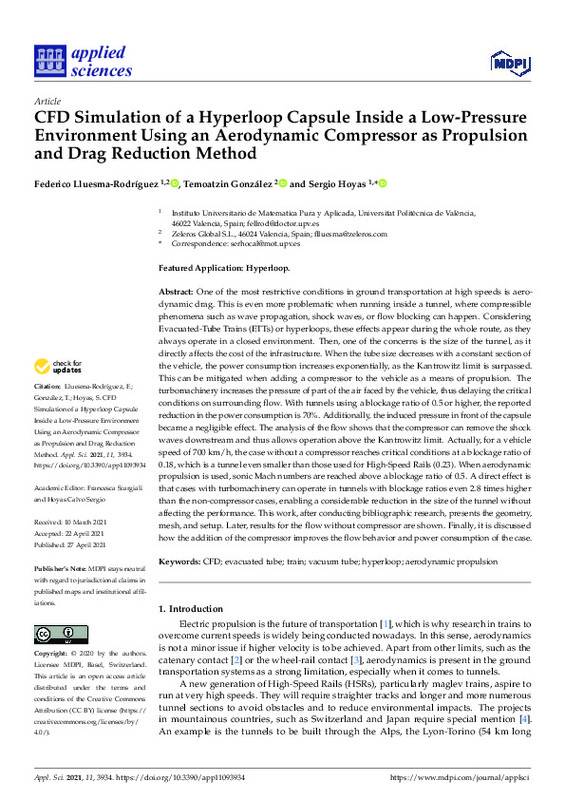JavaScript is disabled for your browser. Some features of this site may not work without it.
Buscar en RiuNet
Listar
Mi cuenta
Estadísticas
Ayuda RiuNet
Admin. UPV
CFD Simulation of a Hyperloop Capsule Inside a Low-Pressure Environment Using an Aerodynamic Compressor as Propulsion and Drag Reduction Method
Mostrar el registro sencillo del ítem
Ficheros en el ítem
| dc.contributor.author | Lluesma-Rodríguez, Federico
|
es_ES |
| dc.contributor.author | Gonzalez, Temoatzin
|
es_ES |
| dc.contributor.author | Hoyas, S
|
es_ES |
| dc.date.accessioned | 2022-05-20T18:06:03Z | |
| dc.date.available | 2022-05-20T18:06:03Z | |
| dc.date.issued | 2021-05 | es_ES |
| dc.identifier.uri | http://hdl.handle.net/10251/182759 | |
| dc.description.abstract | [EN] One of the most restrictive conditions in ground transportation at high speeds is aerodynamic drag. This is even more problematic when running inside a tunnel, where compressible phenomena such as wave propagation, shock waves, or flow blocking can happen. Considering Evacuated-Tube Trains (ETTs) or hyperloops, these effects appear during the whole route, as they always operate in a closed environment. Then, one of the concerns is the size of the tunnel, as it directly affects the cost of the infrastructure. When the tube size decreases with a constant section of the vehicle, the power consumption increases exponentially, as the Kantrowitz limit is surpassed. This can be mitigated when adding a compressor to the vehicle as a means of propulsion. The turbomachinery increases the pressure of part of the air faced by the vehicle, thus delaying the critical conditions on surrounding flow. With tunnels using a blockage ratio of 0.5 or higher, the reported reduction in the power consumption is 70%. Additionally, the induced pressure in front of the capsule became a negligible effect. The analysis of the flow shows that the compressor can remove the shock waves downstream and thus allows operation above the Kantrowitz limit. Actually, for a vehicle speed of 700 km/h, the case without a compressor reaches critical conditions at a blockage ratio of 0.18, which is a tunnel even smaller than those used for High-Speed Rails (0.23). When aerodynamic propulsion is used, sonic Mach numbers are reached above a blockage ratio of 0.5. A direct effect is that cases with turbomachinery can operate in tunnels with blockage ratios even 2.8 times higher than the non-compressor cases, enabling a considerable reduction in the size of the tunnel without affecting the performance. This work, after conducting bibliographic research, presents the geometry, mesh, and setup. Later, results for the flow without compressor are shown. Finally, it is discussed how the addition of the compressor improves the flow behavior and power consumption of the case. | es_ES |
| dc.description.sponsorship | This research was funded by Mineco/FEDER grant number RTI2018-102256-B-I00 and the author Federico Lluesma-Rodriguez was partially funded by Ministerio de Ciencia, Innovacion y Universidades under the grant "Doctorandos Industriales" number DI-17-09616. | es_ES |
| dc.language | Inglés | es_ES |
| dc.publisher | MDPI AG | es_ES |
| dc.relation.ispartof | Applied Sciences | es_ES |
| dc.rights | Reconocimiento (by) | es_ES |
| dc.subject | CFD | es_ES |
| dc.subject | Evacuated tube | es_ES |
| dc.subject | Train | es_ES |
| dc.subject | Vacuum tube | es_ES |
| dc.subject | Hyperloop | es_ES |
| dc.subject | Aerodynamic propulsion | es_ES |
| dc.subject.classification | INGENIERIA AEROESPACIAL | es_ES |
| dc.title | CFD Simulation of a Hyperloop Capsule Inside a Low-Pressure Environment Using an Aerodynamic Compressor as Propulsion and Drag Reduction Method | es_ES |
| dc.type | Artículo | es_ES |
| dc.identifier.doi | 10.3390/app11093934 | es_ES |
| dc.relation.projectID | info:eu-repo/grantAgreement/AEI/Plan Estatal de Investigación Científica y Técnica y de Innovación 2017-2020/RTI2018-102256-B-I00/ES/TRANSFERENCIA DE CALOR EN FLUJOS DE PARED: CANALES Y CAPAS LIMITES/ | es_ES |
| dc.relation.projectID | info:eu-repo/grantAgreement/MCIU//DI-17-09616/ | es_ES |
| dc.rights.accessRights | Abierto | es_ES |
| dc.contributor.affiliation | Universitat Politècnica de València. Departamento de Máquinas y Motores Térmicos - Departament de Màquines i Motors Tèrmics | es_ES |
| dc.description.bibliographicCitation | Lluesma-Rodríguez, F.; Gonzalez, T.; Hoyas, S. (2021). CFD Simulation of a Hyperloop Capsule Inside a Low-Pressure Environment Using an Aerodynamic Compressor as Propulsion and Drag Reduction Method. Applied Sciences. 11(9):1-21. https://doi.org/10.3390/app11093934 | es_ES |
| dc.description.accrualMethod | S | es_ES |
| dc.relation.publisherversion | https://doi.org/10.3390/app11093934 | es_ES |
| dc.description.upvformatpinicio | 1 | es_ES |
| dc.description.upvformatpfin | 21 | es_ES |
| dc.type.version | info:eu-repo/semantics/publishedVersion | es_ES |
| dc.description.volume | 11 | es_ES |
| dc.description.issue | 9 | es_ES |
| dc.identifier.eissn | 2076-3417 | es_ES |
| dc.relation.pasarela | S\440925 | es_ES |
| dc.contributor.funder | Agencia Estatal de Investigación | es_ES |
| dc.contributor.funder | European Regional Development Fund | es_ES |
| dc.contributor.funder | Ministerio de Ciencia, Innovación y Universidades | es_ES |








